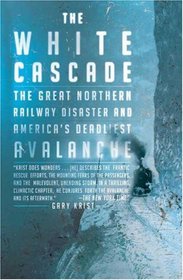Helpful Score: 3
A book about the great avalanche of 1910 that hit Washington. Full of details leading up to the avalanche and descriptions of the resues that took place afterwards. Gary Krist includes his notes, a passengar list, and photos in this well written book.
I began reading Krist's book on the hottest day of the year, which is perhaps one of the reasons I enjoyed it so much; it does an admirable job creating the cold, endlessly-snowy atmosphere of late February 1910 deep in the Pacific Northwest. There, a passenger train and a mail train are trapped, awaiting passable conditions during a many-day blizzard.
Much of the book describes the day-to-day changes along the railroad line, especially the workers' struggles to keep the line clear after numerous and very dangerous "snow slides." Krist describes the understandable growing sense of frustration of the passengers. The most compelling aspect of the book is its description of the countless decisions the railroad engineers have to make as problems mount. As one rotary (a huge "snowblower") breaks down, another must be located. Then a snow slide stops it. Then there isn't enough coal. Then another snow slide occurs ahead on the line. Underpaid shovelers quit. Food supplies dwindle. Etc. etc. etc. So should the passengers attempt to risk their lives and hike out, despite treacherous conditions? What would I have done, had I been a passenger?
The book also contains a wealth of information about the economy and state of transportation in the early 1900s, as well as much biographical information about the Great Northern's founder and chairman James J. Hill and especially superintendent of the GN's Cascade Division James H. O'Neill. Krist presents an unbiased view of both men weighing safety, family, and financial concerns while they guess about meteorological probability. O'Neill is an especially fascinating character.
Most readers know the outcome: an avalanche will toss both trains off the mountain, and nearly a hundred people will die in the disaster. Many of those people are mentioned specifically, but I found it challenging to keep track of more than a few. I recommend that a reader makes a list along the way.
I also wanted more of the science of the compounding storms, but, as Krist notes, "Avalanche science was barely in its infancy in 1910..." (249).
The book includes information about the inquest and legalities following the tragedy, as well as some information about the Great Northern's upgrades and an extensive list of research notes.
The Wellington avalanche remains one of the worst railway disasters in American history. In fact, wreckage is still being discovered.
Much of the book describes the day-to-day changes along the railroad line, especially the workers' struggles to keep the line clear after numerous and very dangerous "snow slides." Krist describes the understandable growing sense of frustration of the passengers. The most compelling aspect of the book is its description of the countless decisions the railroad engineers have to make as problems mount. As one rotary (a huge "snowblower") breaks down, another must be located. Then a snow slide stops it. Then there isn't enough coal. Then another snow slide occurs ahead on the line. Underpaid shovelers quit. Food supplies dwindle. Etc. etc. etc. So should the passengers attempt to risk their lives and hike out, despite treacherous conditions? What would I have done, had I been a passenger?
The book also contains a wealth of information about the economy and state of transportation in the early 1900s, as well as much biographical information about the Great Northern's founder and chairman James J. Hill and especially superintendent of the GN's Cascade Division James H. O'Neill. Krist presents an unbiased view of both men weighing safety, family, and financial concerns while they guess about meteorological probability. O'Neill is an especially fascinating character.
Most readers know the outcome: an avalanche will toss both trains off the mountain, and nearly a hundred people will die in the disaster. Many of those people are mentioned specifically, but I found it challenging to keep track of more than a few. I recommend that a reader makes a list along the way.
I also wanted more of the science of the compounding storms, but, as Krist notes, "Avalanche science was barely in its infancy in 1910..." (249).
The book includes information about the inquest and legalities following the tragedy, as well as some information about the Great Northern's upgrades and an extensive list of research notes.
The Wellington avalanche remains one of the worst railway disasters in American history. In fact, wreckage is still being discovered.




![header=[] body=[Get a free book credit right now by joining the club and listing 5 books you have and are willing to share with other members!] Help icon](/images/question.gif?v=52444873)
